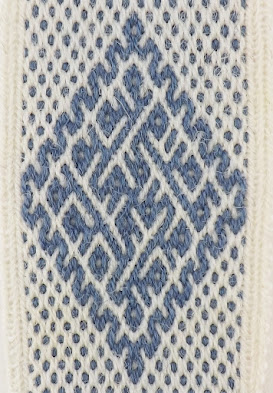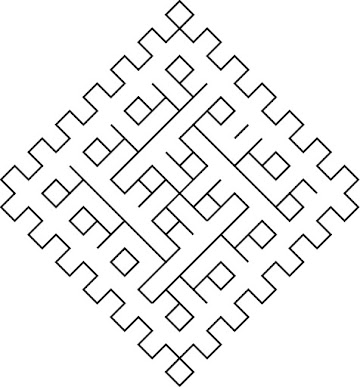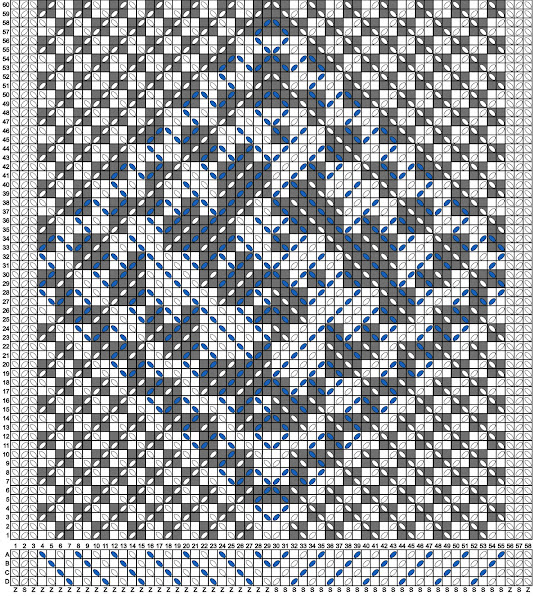This draft is from one of the two bands I designed based on the Hildesheim cope (held by the Victoria & Albert Museum, UK) for my book Tablet Weaving in Theory and Practice: Golden Diagonals. You can find a further six that use the same threading diagram in the section on the Hildesheim cope in the book. Golden Diagonals is an exploration of 11th century to 14th century gold brocaded bands (known as orphreys) from certain types of vestments. There a total of 15 bands in the book, based on 8 extant objects: the chasuble of St. Vitalis, the chasuble of St. Wolfgang, the chasuble of St. Heinrich, fragments of a chasuble orphrey cross, V&A 1256-1864, V&A 838-1894, the Hildesheim cope, and the orphrey of abbot John Dygon. I've translated many of the motifs into other tablet woven structures: warp-twining, simple double-face, warp-floats, threaded-in, Icelandic vacant-hole, and two-hole weaving, as well as including two bands in the brocade of the originals.
The Hildesheim cope (V&A inventory number: 17-1873), would have been worn by Christian priests during processions as a cape-like garment over other vestments. It is a masterpiece of German brick-stitch embroidery storytelling, depicting the martyring of 29 different saints in bright, colourful silks. Each of the saints and their tormentors are housed in a circle which overlaps its neighbours, forming curved-edged hexagons, and wear clothing decorated in geometric designs. While the congregation in early 14th-century Germany, where the cope was made, may not all have been literate, they would have recognised the symbolism in each of the hexagons and been able to identify each saint when they came into view as the priest moved and the folds of the garment shifted.
The two tablet woven orphreys on the cope hold pride of place, where they would have been most noticeable during use. It is believed that the bands (possibly from Köln, Germany[1]) are not original to the vestment and were added during later reshaping work. The band I describe as the "vertical orphrey" would have hung down the priest's spine, on the centre-back of the garment and the band I describe as the "horizontal orphrey" would have been worn as two vertical strips down the priest's front. The vertical orphrey is the wider of the two bands and is decorated with large lozenges framing a single repeated spiralling motif, brocaded alternately in blue and two other colours of silk (which are unfortunately now badly faded).
You can read more about the cope itself and its horizontal and vertical orphreys in Tablet Weaving in Theory and Practice: Golden Diagonals. The motifs of two smaller brocaded tablet woven bands that form the edgings of the vertical orphrey and the vestigial hood are described in my book Tablet Weaving in Theory and Practice: Vacant-Hole Pinwheels Revised Edition.
I adapted this band (Band 13 of Golden Diagonals) from the repeating motif on the vertical orphrey of the Hildesheim cope, with two additional motifs inspired by some of the weaving errors on the orphrey. Of the 11 motifs currently visible on the orphrey (there may be a 12th hidden behind the vestigial hood), 9 include at least one error, although their commonalities suggest that they were intended to be identical. Such errors are reasonably common in such bands, especially where the weave structure is complex and uses a large number of tablets, dissuading the weaver from undoing their work to make corrections[2][3].
You can download the TDD file for this draft by clicking here.
You can download the text version of this draft by clicking here.
References
[1] Epe, E. et al. (1991). Schatzkammer auf Zeit. Die Sammlungen des Bischofs Eduard Jakob Wedekin, 1769-1870, Diözesan-Museum Hildesheim. (pp. 168-9)
[2] Hansen, E. (1990). Tablet Weaving: History, Techniques, Colours, Patterns, Hovedland Publishers.
[3] Ræder Knudsen, L. (2004). Written Patterns in Early Tablet Weaving, In: Priceless Invention of Humanity: Textiles. North European Symposium for Archaeological Textiles VIII. (pp. 121-128)
As with all of the free patterns/drafts on this site, you are welcome to weave them, sell bands woven using them, and use them to teach other weavers, just as long as you state where you found them.




No comments:
Post a Comment